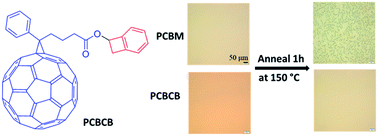Thermo-cross-linkable fullerene for long-term stability of photovoltaic devices†
Abstract
In this study, a highly soluble PCBM-based thermo-cross-linkable fullerene precursor has been synthesized for use in bulk heterojunction based organic solar cells. The cross-linking was achieved using a thermally activated benzocyclobutene (BCB) molecule. The thermo-crosslinking reaction is initiated at temperatures as low as 150 °C. Compared to PCBM, the cross-linked fullerene is highly insoluble and has a diffusional mobility in poly(3-hexylthiophene) (P3HT) that is an order of magnitude slower than PCBM. Its electron mobility is comparable to that of PCBM and organic photovoltaic (OPV) devices consisting of bulk heterojunction active layers with P3HT or PTB7 and this fullerene show very similar efficiencies. Devices prepared either with pure cross-linked fullerene or its mixture with PCBM as acceptors in OPVs have been shown to be highly stable to accelerated aging with little loss in device efficiency up to 48 hours of aging at 150 °C. This compares to a loss of 60% of initial efficiency in identically prepared devices when using PCBM as the acceptor. Optical microscopy and grazing incidence wide angle X-ray scattering (GIWAXS) shows that a probable cause for this excellent stability in the cross-linked fullerene containing BHJs is associated with a significant inhibition of formation of crystals of fullerene.


 Please wait while we load your content...
Please wait while we load your content...